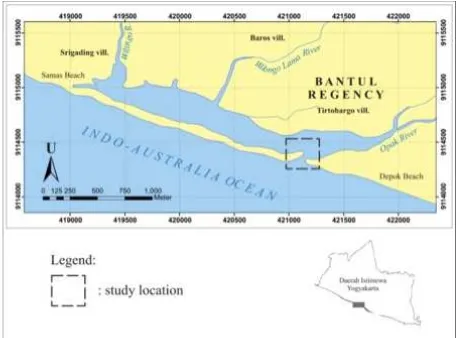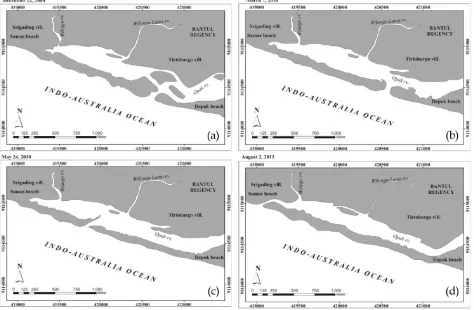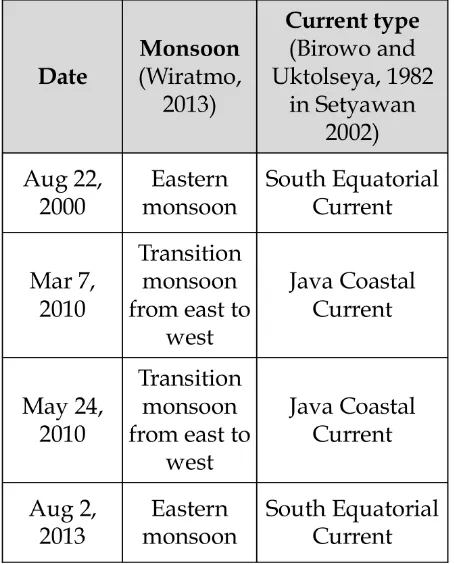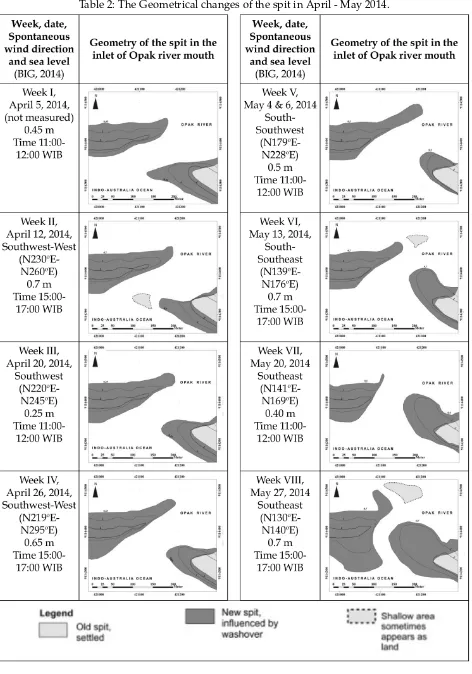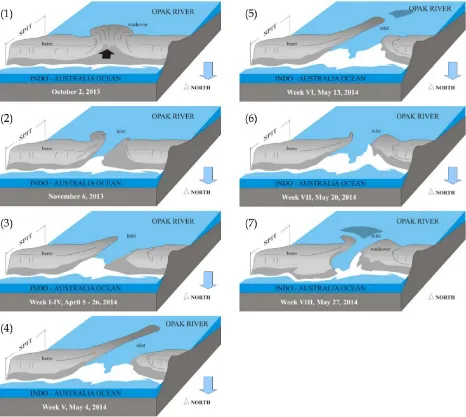DYNAMIC MORPHOLOGICAL CHANGES OF
SPIT IN APRIL–MAY 2014 IN OPAK RIVER
MOUTH, BANTUL, DAERAH ISTIMEWA
YOGYAKARTA
Yan Restu Freski, Agung Setianto∗, and Srijono
Geological Engineering Department, Faculty of Engineering, Universitas Gadjah Mada
Abstract
As an oceanic coast, the beaches in the southern part of Java Island are predominantly influenced by ocean energy which is driven by periodical monsoon. This periodical process impacts the dynamic changes of spit in the river mouth system. Therefore, spit is a key to study the process in the southern coast of Java Island especially in Opak River Mouth. It needs a deep-root explanation about the morpholog-ical changes and the sedimentologmorpholog-ical mechanism. This research project was built by data such as spit geometry, aerial photographs and spontaneous wind direction. The supporting data included multi-temporal IKONOS-Quickbird images from Google Earth and aerial photographs. These data were col-lected from field-work investigation and laboratory-work. The spit geometry was compiled by Global Po-sitioning System handheld tracking along the edge of spit and crosschecked by aerial photograph using pole. The ultimate interpretation and periodic mod-els were built by data reconstruction based on the ge-ometry of spit and spontaneous wind direction. Spit changed weekly due to monsoon transition in April to May 2014. The morphological changes could be noted as the spit starting to be cut off by the high-rate flow of Opak River. The process continued until the net drift moving westward.
Keywords: April, coast, May, Opak river mouth, spit.
∗Corresponding author: A. SETIANTO, Geological En-gineering Department, Faculty of EnEn-gineering, Universi-tas Gadjah Mada. Jl. Grafika No. 2 Yogyakarta 55281, Indonesia. E-mail: agung [email protected]
1 Introduction
Coastal area reflects to the results of oceanic and fluvial energies (Komar, 1976). The coastline of Java Island in Indonesia is approximately 3000 km long (Zazoeli and Negoro, 1989). The southern part of the coast which faces directly to Indo-Australia Ocean, has some distinct fea-tures due to the oceanic waves and current. The oceanic processes depend on the periodi-cal monsoon throughout years (Tjasyono, 2004). The influence can be seen on the spit, the river mouth bar along the beach (Komar, 1976).
Figure 1: The study area in Opak River mouth, Bantul, Daerah Istimewa Yogyakarta.
– 421280 and 9114250 – 9114525. The situation of the area can be seen at Figure 1.
The questions of this research is how was the dynamic changes of morphology of the spit during transitional monsoon (April – May 2014)? The research focused on the inlet of the Opak river mouth which had a clear movement of the spit. The time of this investigation was April to May 2014 which was presumed as tran-sition monsoon from west to east.
2 Materials and methods
This research project was built by data such as spit geometry and aerial photographs scaled 1:30. The supporting data included multi-temporal IKONOS and or Quickbird images from Google Earth (March 7, 2010; May 24, 2012; and August 2, 2013) and aerial pho-tographs scaled 1:25.000. These data were collected from field-work investigation and laboratory-work. The spit geometry was
com-ment using the compass. The area of study is rich by ferromagnetic minerals (magnetite, ilmenite, etc.) and it might affect the com-pass needle. By this condition, the wind di-rection data was crosschecked by Badan Infor-masi Geospasial (BIG) data. This was also com-pleted by the time when it was gathered and mentioned as the spontaneous direction. This wind data gives small representatives that com-pared to the global wind.
3 Results and discussion
Opak Spit can be defined as a part of an estuary system. Based on Fairbridge (1980, in Huggett, 2007), the estuary and the spit of Opak can be classified as bar-built estuary while in Wright (1985, in Huggett, 2007), they can be associ-ated with wave dominassoci-ated delta since there are similar features of it. Spit is commonly devel-oped as progradation along the coastline which segmented by river inlet within the spit (Rein-son, 1992). Sandy (1979, in Verstappen, 2000) and Setyawan (2002) also mentioned in geolog-ical time, the southern coast of Central Java has been prograding to the sea.
Table 1: The correlation between date, mon-soon, and global sea currents that applied in Opak river mouth.
There was no plenty run off so the rate of water flow declined even in the river mouth. The river energy dropped out and became lower than the sea which was precisely increased from east-southeast.
The condition differed on March 7, 2010 which was the end of western monsoon. The inlet formation cut the spit at the eastern arm. It was supported by the high rate of river flow due to the wet season. Simultaneously, the spit elongated to east because of Java Coastal Current as well as on May 24, 2010. The inlet drifted westward on March 7, 2010. The coastal
(from west to east) and the Java Coastal Current with the inlet position took a place in the east part of spit. (Birowo dan Uktolseya, 1982, in Setyawan, 2002). The sequences can be seen in 3-dimensional model at Figure 3.
In studying the double spits, a comprehen-sive observation must be applied. The spit would extend along the drift direction (Swan, 1983 in Setyawan, 2002). In the study area, the spit condition in October 2013 still covered by the washover deposits with approximately 150×100 meter along to the estuary. The over-weigh washover might caused the vertical ero-sion of the spit. It led new inlet formation as in November 2013, a month later (Srijono dan Freski, 2013). The new inlet had the rate of flow approximately 0.1 – 1.0 m/s.
The shape changing of the spit was obviously observed by geometry aspect. In April – May 2014, its geometry became wider and showed the drifting to west. Its changes appropriate with the transitional trend of wind direction from eastward to westward (Wiratmo, 2013). The effective drifting of the spit also showed the concepts from Birowo and Uktolseya (1982, in Setyawan, 2002). Srijono and Freski (2013) con-cluded that November 2013 as the time of the spit cutting can be justified as the last datum of spit growth eastward. It means, the inter-val time between April to May 2014 can be pre-sumed as the early datum of spit growth west-ward.
4 Conclusions
Acknowledgment
A grateful expression is addressed to Labora-tory of Dynamic Geology and LaboraLabora-tory of Sedimentology of Geological Engineering De-partment, University of Gadjah Mada who has supported the research.
References
Anonim (2014) Images IKONOS-Quickbird dated March 7, 2010, May 24 2012, and Au-gust 2, 2013 accessed from Google Earth, August 19, 2014.
Freski, Y.R. and Darmadi (2012) Analisis pem-belokan aliran Sungai Opak saat bermuara di Samudra Hindia. Dalam Prosiding PIT IAGI ke-41, Yogyakarta.
Hendratno, A. (2000) Kondisi Geologi Untuk Pengembangan Lingkungan Fisik Wilayah Pesisir Selatan Yogyakarta Antara Muara Sungai Opak dan Girijati. Master Thesis in Postgraduate School of Universitas Gadjah Mada, Yogyakarta.
Huggett, R.J. (2007) Fundamentals of Geomor-phology 2nd Edition. Routledge, New York, 483h.
Komar, P.D. (1976) Beach Processes and Sedi-mentation. Prentice Hall, New Jersey, 429p. Leeder, M. (1999) Sedimentology and
Sedimen-tary Basins from Turbulence to Tectonics. Blackwell Publishing, United States, 581p. Reinson, G.E. (1992) Transgressive Barrier
Is-land and Estuarine Systems. Dalam: Walker, R.G. dan James, N.P. Facies Models Response to Sea Level Changes. Geological Association of Canada Publications, Canada.
Setyawan, W.B. (2002) Bentang alam pantai di pesisir selatan Jawa Tengah. Sumber Daya Geologi Daerah Istimewa Yogyakarta dan Jawa Tengah. Pengurus Daerah Ikatan Ahli Geologi DIY & Jawa Tengah.
Soetoto dan Widiasmoro (1987) Concepts of coastal region development in Southern Yogyakarta Province based on geological data through Landsat imagery and aerial-photographs interpretations. Proceeding of Ann. Reg. Meet. IAGI, Jakarta.
Subardi (1994) Geologi Pantai Parangtritis, Yo-gyakarta. Proceeding of Ann. Meet. IAGI XXIII, Jakarta.
Surjono, S. S. (2001) Geodinamika Muara Sun-gai Serang dan Bogowonto Kabupaten Kulon Progo Daerah Istimewa Yogyakarta Seba-gai Pertimbangan Rencana Pengembangan Wilayah. Master Thesis in Postgraduate School of Universitas Gadjah Mada, Yo-gyakarta.
Srijono and Freski, Y.R. (2013) Mekanisme pem-bentukan spit pada muara Sungai Opak dalam morfodinamika pesisir selatan Pu-lau Jawa berdasarkan analisis citra multi-temporal. Proceeding of National Seminar, Geological Engineering Department, FoE UGM, Yogyakarta.
Tim Morfodinamika Pesisir (2009) Studi Morfo-dinamika Wilayah Pesisir Selatan Kabupaten Bantul dan Kabupaten Cilacap. Internal Re-port of Laboratory of Geospatial, Yogyakarta. Tjasyono, B. (2004) Klimatologi. ITB Publisher,
Bandung.
Triatmodjo, B. (1999) Teknik Pantai. Beta Offset, Yogyakarta, 396p.
Verstappen, H.T. (2000) Outline of the Geo-morphology of Indonesia: A Case Study On Tropical Geomorphology of A Tecto-gene Region. ITC-International Institute for Aerospace Survey and Earth Sciences, The Netherlands, 198h.
Wiratmo (2013) A Course of Introductory of Cli-matology and Meteorology in Earth Sciences Olympiad Training. Unpublished.
